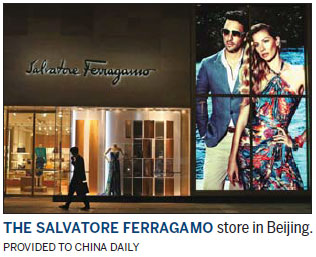Spending on luxury goods slows down
Consumers have become critics and creators, dictating when and where they engage with high-end brands
Sales of luxury goods on the Chinese mainland and Hong Kong have continued to fall, with consumer confidence weakened by the economic slowdown, industry analysis shows.
Deloitte's annual Global Powers of Luxury Goods report, released on June 7, says the top 100 luxury goods companies saw average sales of $2.2 billion last year.
Salvatore Ferragamo SpA generated 321 million euros ($358 million) in revenue in the first quarter of this year, down 1.8 percent year-on-year, according to its interim financial results.
Revenues in the Asia-Pacific region, the company's top market, fell by 3 percent year-on-year from January to March, mainly due to deterioration of the business in Hong Kong and Macao.
Prada SpA, which is traded on the Hong Kong Stock Exchange, saw profits for the year ending Jan 31 plummet 26.6 percent, from 4.5 billion euros to 3.3 billion euros, the Deloitte report says.
China is still driving much of the volume growth in luxury travel products, and this will continue as the next generation of potential luxury shoppers enters the workforce, the Deloitte report says.

Overall, Chinese consumers are the travel sector's biggest spenders and remain strategically important for luxury brands. The country has more than 400 million millennials, more than the United States and Europe combined.
Prices are no longer this group's priority, however. Instead, they are more keen on buying high-quality brands that have character, the report says.
Many wealthy Chinese are staying away from the Hong Kong market, it says, explaining that middle-class consumers are turning to overseas markets and cross-border e-retailers.
On the mainland, the slowing economy has resulted in less spending, while government anti-corruption measures targeting luxury gifts in the corporate sector have also had an effect.
"There is a shift in the luxury path-to-purchase," says Patrizia Arienti, an expert on the luxury sector at Deloitte Global. "Empowered by social networks and digital devices, consumers are dictating increasingly when, where and how they engage with luxury brands.
"They have become critics and creators, demanding a more personalized luxury experience. They expect to be given the opportunity to shape the products and services they consume."
Ira Kalish, chief economist at Deloitte Global, adds, "The global luxury goods sector is expected to grow more slowly this year, at a rate many retailers may find disappointing.
"The growth rate is slowing in important markets such as China and Russia, although there are pockets of opportunity across the globe. India and Mexico, for example, are growing quickly, and the Middle East offers further growth potential."
The report adds that profit margins for luxury goods companies were higher in 2015 than the previous year, and the polarization of company performances was greater, with more high performers achieving double-digit sales growth and profit margins, while others experienced double-digit sales declines.
Italy is once again the luxury goods leader in terms of the number of companies. With 29 firms in the top 100, it has more than double the US, the country with the second-largest number. However, Italian companies account for just 17 percent of luxury goods sales among the top 100, as they are predominantly smaller, family-owned companies.
wangzhuoqiong@chinadaily.com.cn


















